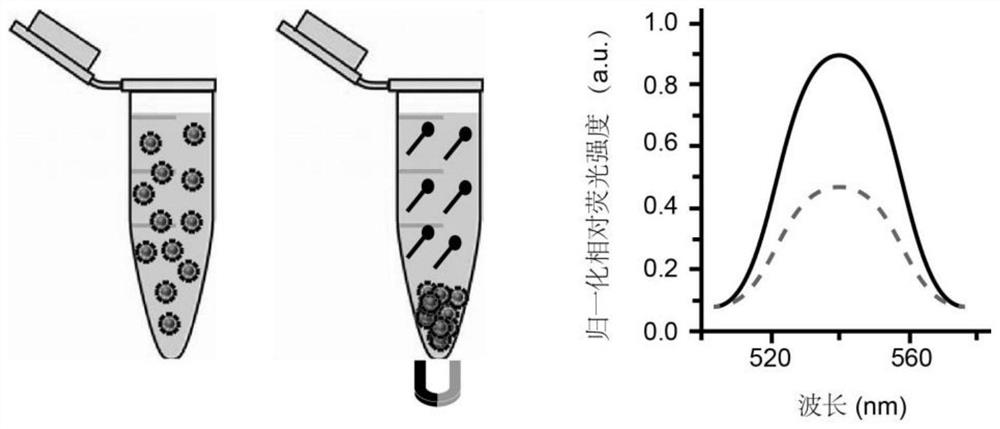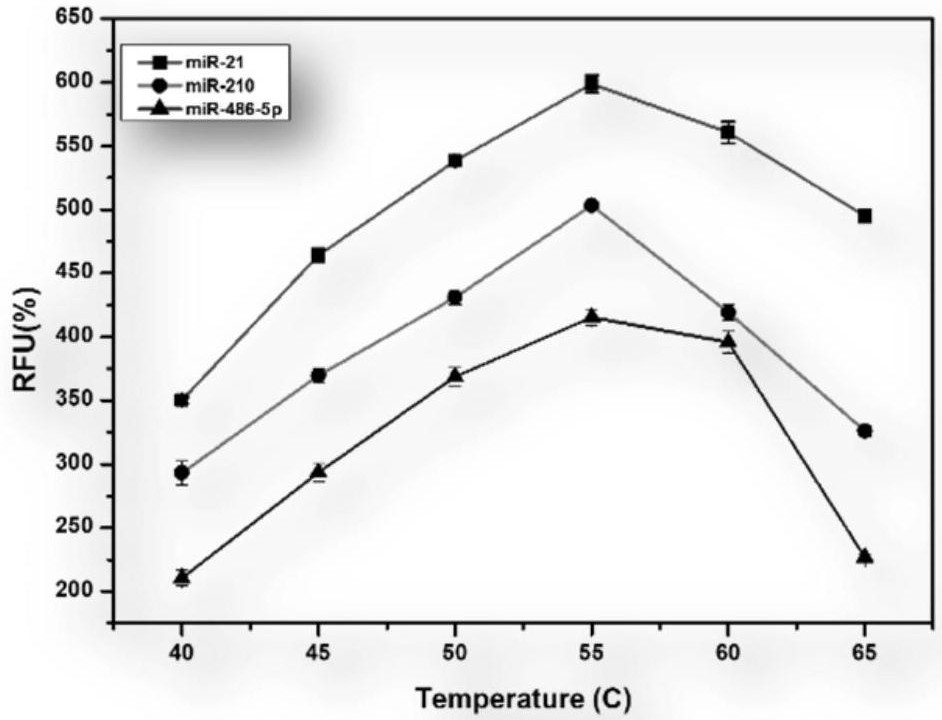Composite locked nucleic acid magnetic bead probe for detecting miRNA marker, construction method and diagnostic reagent containing probe
A technology of locked nucleic acid probe and construction method, applied in the field of composite locked nucleic acid magnetic bead probe and diagnostic reagent, can solve the problems of low expression amount, low sensitivity, large sample volume requirement, etc., achieve strong binding force and reduce background signal Effect
- Summary
- Abstract
- Description
- Claims
- Application Information
AI Technical Summary
Problems solved by technology
Method used
Image
Examples
Embodiment 1
[0043] Example 1 Selection of the optimal incubation temperature
[0044] 1. DNA probe preparation
[0045] According to the molecular base sequence of the marker miRNA486-5p to be detected, the corresponding locked nucleic acid (LNA) was synthesized as the capture probe LNA probe-486-5p, and the FAM fluorophore and biotin and other molecules were modified at both ends respectively. .
[0046] 2. DNA probe molecules immobilized on magnetic beads
[0047] The superparamagnetic microspheres are covalently combined with high-purity streptavidin to form streptavidin magnetic beads (streptavidinMBs, SMBs). Filter off the supernatant and redisperse into 2×B&W buffer. An appropriate amount of LNA probe molecules were preheated at 95°C for 5 minutes to eliminate the cross-hybridization phenomenon, and then mixed with the SMBs suspension, and the concentration of each LNA in the prepared test solution was 1 μM. Slightly shake the test solution and incubate at 37°C for 20 minutes to...
Embodiment 2
[0055] Example 2 Minimum detection concentration test
[0056] 1. DNA probe preparation
[0057] According to the molecular base sequence of the marker miRNA486-5p to be detected, the corresponding locked nucleic acid (LNA) was synthesized as the capture probe LNA probe-486-5p, and the FAM fluorophore and biotin and other molecules were modified at both ends respectively. .
[0058] 2. DNA probe molecules immobilized on magnetic beads
[0059] The superparamagnetic microspheres are covalently combined with high-purity streptavidin to form streptavidin magnetic beads (streptavidinMBs, SMBs). Filter off the supernatant and redisperse into 2×B&W buffer. An appropriate amount of LNA probe molecules were preheated at 95°C for 5 minutes to eliminate the cross-hybridization phenomenon, and then mixed with the SMBs suspension, and the concentration of each LNA in the prepared test solution was 1 μM. Slightly shake the test solution and incubate at 37°C for 20 minutes to better cou...
Embodiment 3
[0070] Example 3 Cross-reaction degree test
[0071] 1. DNA probe preparation
[0072] According to the molecular base sequence of the marker miRNA486-5p to be detected, the corresponding locked nucleic acid was synthesized as the capture probe LNAprobe-486-5p, and the FAM fluorophore and biotin and other molecules were modified at both ends.
[0073] 2. DNA probe molecules immobilized on magnetic beads
[0074]Superparamagnetic microspheres are covalently combined with high-purity streptavidin to form streptavidin magnetic beads (streptavidinMBs, SMBs). At room temperature, take a certain amount of SMBs and wash them with 1×B&W buffer. Filter off the supernatant, and then disperse into 2×B&W buffer. Take an appropriate amount of LNA detection molecules and preheat them at 95°C for 5 minutes to clear the cross-hybridization phenomenon, and then mix them with the SMBs suspension. The concentration of each LNA in the prepared test solution is 1 μM. Shake the test solution sli...
PUM
 Login to View More
Login to View More Abstract
Description
Claims
Application Information
 Login to View More
Login to View More - R&D
- Intellectual Property
- Life Sciences
- Materials
- Tech Scout
- Unparalleled Data Quality
- Higher Quality Content
- 60% Fewer Hallucinations
Browse by: Latest US Patents, China's latest patents, Technical Efficacy Thesaurus, Application Domain, Technology Topic, Popular Technical Reports.
© 2025 PatSnap. All rights reserved.Legal|Privacy policy|Modern Slavery Act Transparency Statement|Sitemap|About US| Contact US: help@patsnap.com



